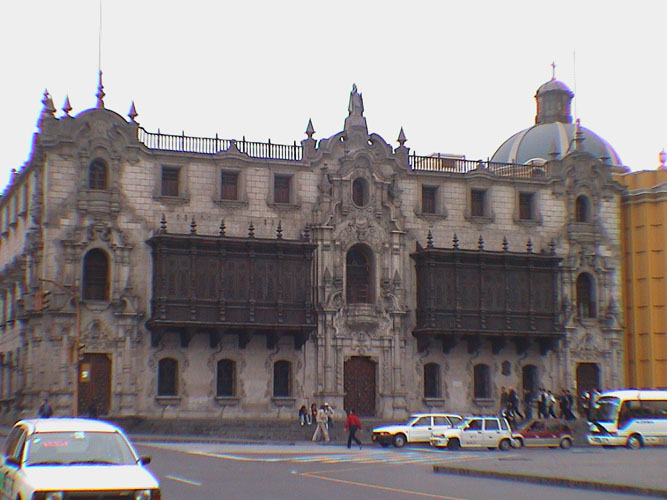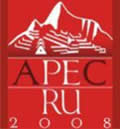United Kingdom
| Welcome |
| Peru in Brief |
| History |
| Geography |
| Government & Politics |
| Maritime delimitation between Peru and Chile |
| News |
Links |
| LIMA | |||
 |
|||
| Palace of the Archbishop | |||
| Places of Interest: | MUSEUMS | ||
National Museum of Archaeology, Anthropology and History. Informative, chronologically ordered exhibits describe each of the cultures that flourished in Peru – notably the Chavin, Nazca, Paracas, Mochica, Chimu, Wari, and the Inca. The adjoining edifice (and former residence of the viceroys Pezuela and La Serna as well as of the liberators Bolivar and San Martin ) contains paintings, documents and other memorabilia from the colonial period, the wars of Independence and more recent republican times. |
|||
Gold Museum. The collection (which belongs to the Peruvian statesman and philanthropist Miguel Mujica Gallo's family) comprises thousands of gold items – collars, funeral masks, ceremonial cups, sceptres, ritual knives or tumis, nose ornaments, idols, etc. – illustrating the progress of the precious metal crafts in ancient Peru. A sizeable collection of ancient weapons from various parts of the world may also be viewed. |
|||
Rafael Larco Herrera Archaeological Museum. This interesting collection of ceramics, textiles and jewellery mostly from northern Peru includes a section on erotic pottery and a vault containing gold ornaments. |
|||
| Museo de la Nacion. The museums ample rooms provide a comprehensive historical representation of ancient Peru through replicas of archaeological sites, two- and three-dimensional displays and collections such as that of present-day regional costumes. | |||
| Museo A mano. A private collection featuring select pre-colonial pottery and textiles. | |||
| Museo de Arte. Spanning 3,000 years of Peruvian history, items include pre-Columbian pottery and textiles, colonial furniture, silverware, clothes (“tapadas”), and paintings by Cuzco School , early republican and contemporary artists. Central Reserve Bank. Pre-colonial pottery, coins, paintings. |
|||
San Francisco el Grande. Liturgical objects from the colonial period, woodwork, paintings by Zurbaran. National Congress Museum / The Inquisition. The audience chamber has a magnificent coffered ceiling. Cells with prisoners' inscriptions and rooms containing punishment devices used by the Inquisition may also be visited. |
|||
| Museum of Peruvian Culture. Pre-colonial craft products include pottery, textiles, leather goods and sacred images. | |||
| Javier Prado Natural History Museum ( University of San Marcos ). An interesting collection of animals, plants and minerals of Peru assembled by the Italian naturalist Antonio Raimondi . | |||
Convento de los Descalzos. Fine colonial paintings and religious objects. |
|||
| Museo de la Casona of the University of San Marcos. The museum holds collections of Chavin pottery and pre-Columbian musical instruments, in addition to the university's latest archaeological finds. | |||
Art and History Museum ( University of San Marcos ). The Alicia Bustamante and Pablo Macera collections: colonial art, books, documents, furniture, antique craft objects. |
|||
| Museo Taurino. Paintings, costumes, trophies and photographs of the most famous bullfighters. Colonial Buildings |
|||
| Palace of Torre Tagle. The architecture of this early 18th-century palace (and seat of the Ministry of Foreign Affairs) combines Seville , Mudejar and colonial styles. The stone front is set between two carved balconies that are by far the finest in Lima . | |||
| Casa de Pilatos. A 16th-century building now used by the Institute Nacional de Cultura, with stone columns and a monumental staircase leading to the entrance. | |||
| Casa Aliaga. The site is that of the ancient shrine honouring Taulichusco, a paramount chief of the Rimac valley. In founding Lima , Francisco Pizarro assigned the land to the conquistador Jeronimo de Aliaga , whose descendants have occupied the mansion ever since – a unique case in the Americas . | |||
| Casa de Oquendo o Palacio de Osambela. Completed in 1807, the house has five balconies and an observatory from which the original owner, Don Martin de Osambela , pointed his spyglass at the ships entering the port of Callao . |
|||
| Fortress of the Real Felipe. Erected to guard the colonial capital against attacks from pirates. | |||
| ARCHAEOLOGICAL SITES AND OTHER TOURIST ATTRACTIONS <Click here> | |||
| <BACK> | |||





